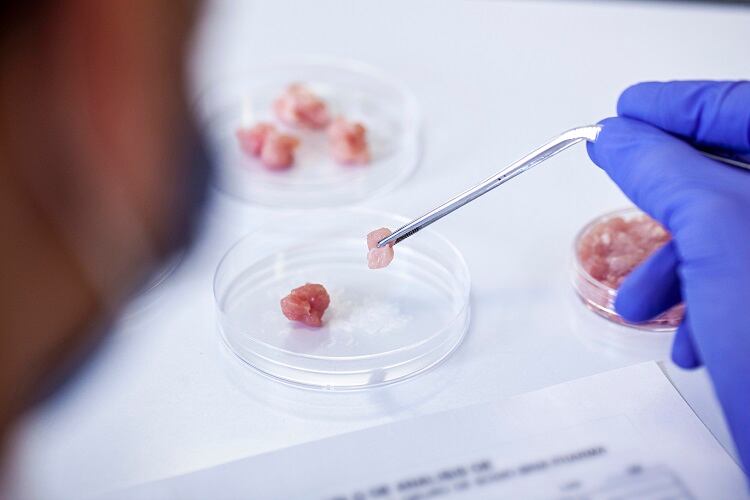Cultivated meat – whereby meat is produced from animal cells using a combination of biotechnology, tissue engineering, molecular biology and synthetic processes – is thought to be a more environmentally sustainable alternative to conventional meat production.
Indeed, much food is considered more environmentally sustainable than intensively produced meat, such as that sourced from livestock. Globally, livestock production contributes an estimated 18% of anthropogenic greenhouse gas (GHG) emissions, is a major contributor to water stress, and a key driver of deforestation.
But a new pre-print study penned by researchers at the University of California, Davis (yet to be certified by peer review), suggests cultured meat production could be worse for the environmental than production of conventional beef.
Cultivated meat more resource intensive than most meat production systems?
The researchers conducted a cradle-to-grave life cycle assessment (LCA) of animal cell-based meat under what they describe as ‘current production methods’. The study used findings from a pre-print cradle-to-production gate LCA of cultured meat growth media, also conducted at UC Davis.
The growth media (which contains the nutrients and growth factors that cells need to grow) used in the researchers’ model is E8 - a growth medium designed for stem cell research, and which researchers believe could be scaled and slightly modified for industrial production of cultivated meat.
“The authors believe that use of E8 or similar refined growth medium will be necessary given in vitro animal cells sensitivity to media impurities in comparison to yeast or bacterial cells,” explained food scientist Derrick Risner and his team at UC Davis.
Results of the cultivated meat life cycle impact assessment (LCIA), which covers all relevant inputs from the environment (such as ores and crude oil, water, land use) as well as emissions into air (e.g., carbon dioxide and nitrogen oxides), suggest that production based on purified growth medium components leads to a greater global warming potential (kg of carbon dioxide equivalent [CO2e]) than beef. It depends on the scenario and which value is used from beef production - which is a scale, explained Risner. The researchers' 25x-4x calculation is derived from the purified scenarios with the reported median beef value.
“Without purification of the growth medium components, the global warming potential of the glucose consumption rate (GCR) is approximately 25% greater than reported median of global warming potential of retail beef.”
Overall, the study indicates that cultivated meat is likely to be more resource intensive than most meat production systems according to the researchers’ analysis.
“We…hope that our LCA will provide evidence of the need for additional critical environmental examination of new food and agriculture technologies,” note the study authors.
Comparisons with earlier research
The study is not the first to suggest cultivated meat production may not be as environmentally sustainable as first thought.
While cultivated meat uses significantly less land and water, production is energy-intensive. Back in 2019, researchers at the Oxford Martin School undertook a comparative study looking at the GHG produced by cultivated and farm-raised beef in the current energy system.
The study suggested that in some cases, the manufacture of cultivate meat can result in more global warming due to the difference in gas emissions: methane vs CO2. Warming as a result of carbon dioxide emitted by the current energy system would persist, whereas warming caused by methane ceases after only a few decades.
At the time, the researchers suggested a ‘large-scale’ transition to a decarbonised energy system would be required to make cultivated meat production the clear winner in the environmental sustainability stakes.

But the UC Davis findings are at odds with some more recent research investigating the environmental sustainability of cultivated meat production.
Earlier this year, a group of international researchers published a study in The International Journal of Life Cycle Assessment (IJLCA) predicting the ex-ante LCA of commercial-scale cultivated meat production in 2030.
Using data from more than 15 companies working in cultivated meat production and its supply chain, the study found that cultivated meat land use is low, and nitrogen-related and air pollutions emissions associated with cultivated meat are also lower than its conventional counterparts.
But as with the 2019 study, the research found that cultivated meat production is energy-intensive. Its carbon footprint is ‘substantially’ lower than that of beef’, the researchers conclude, but how it compares to chicken and pork depends on energy mixes. “While cultivated meat production and its upstream supply chain are energy-intensive, using renewable energy can ensure that it is a sustainable alternative to all conventional meats.”
Spotlight on growth media
The UC Davis study has received criticism from proponents of cultivated meat.
According to international non-profit the Good Food Institute (GFI), ‘several’ key assumptions in the UC Davis study do not align with the ‘current or expected’ practices for sourcing and purification of cell culture media ingredients.
“Cell culture media ingredients can be sourced in a variety of ways. The US Davis authors assume in their study that media ingredients would be produced and purified on an individual basis, as in the pharmaceutical industry,” noted the GFI.
But if the cultivated meat industry were to pursue this method of sourcing and purifying media inputs, the costs would likely be too high for the vast majority of products to be competitive with conventional meat, we were told. “As the UC Davis study demonstrates, it also comes at a high environmental cost. So it wouldn’t make economic or environmental sense for cultivated meat to take this method forward. Nor would it be necessary.”
According to the GFI, cultivated meat companies are aware of these challenges and have been progressively moving towards a media input supply chain that is suitable for use in food production, rather than ‘built for pharmaceuticals’. The IJLCA study, for example, used ‘very different’ assumptions for media inputs, based on input from companies involved in the industry supply chain.

From the UC Davis researchers’ perspective, they’ve been transparent about the growth medium LCA conducted and used in the study, which is available in pre-print: Cradle to production gate life cycle assessment of cultured meat growth media: A comparison of Essential 8™ and Beefy-9. This study has not been certified by peer review.
“We examined an established growth medium (Essential 8) and proposed growth medium (Beefy-9). One key takeaway is that the use of antibiotics in the growth medium can substantially increase the environmental [impact] of the growth medium,” UC Davis’ Risner told FoodNavigator.
“Our life cycle assessment of animal-cell-based meat did not include any antibiotics.”
Study findings subject to change
GFI is also wary of the UC Davis researchers’ findings because the study has not yet been through a full peer review process. This, as GFI points out, means that the study’s assumptions and conclusions are subject to change.
Risner confirmed the articles have been submitted to peer-reviewed journals and explained that pre-prints can be submitted (or even encouraged to be submitted) during the journal submission process, depending on the journal.
“We are open to feedback via peer-review or other relevant avenues that make our work more information,” he told this publication. “These articles are also derived from my PhD dissertation, so that have been reviewed on that level.”
Article updated 23/5/2022 with additional comment from UC Davis' Derrick Risner distinguishing between global warming potential of using purified and impurified growth media.
Sources:
'Environmental impacts of cultured meat: A cradle-to-gate life cycle assessment'
Pre-print posted online 21 April 2023 (yet to be certified by peer review)
DOI: https://doi.org/10.1101/2023.04.21.537778
Authors: Derrick Risner, Yoonbin Kim, Cuong Nguyen, Justin B. Siegel, Edward S. Spang
'Cradle to production gate life cycle assessment of cultured meat growth media: A comparison of Essential 8™ and Beefy-9'
Pre-print posted online 21 April 2023 (yet to be certified by peer review)
DOI: https://doi.org/10.1101/2023.04.21.537772
Authors: Derrick Risner, Patrick Negulescu, Yoonbin Kim, Cuong Nguyen, Justin B. Siegel, Edward S. Spang
Frontiers in Sustainable Food Systems
Climate Impacts of Cultured Meat and Beef Cattle’
Published 19 February 2019
DOI: https://doi.org/10.3389/fsufs.2019.00005
Authors: John Lynch and Raymond Pierrehumbert
The International Journal of Life Cycle Assessment
‘Ex-ante life cycle assessment of commercial-scale cultivated meat production in 2030’
Published 14 December 2022
DOI: https://doi.org/10.1007/s11367-022-02128-8
Authors: Pelle Sinke, Elliot Swartz, Hermes Sanctorum, Coen van der Giesen, Ingrid Odegard




